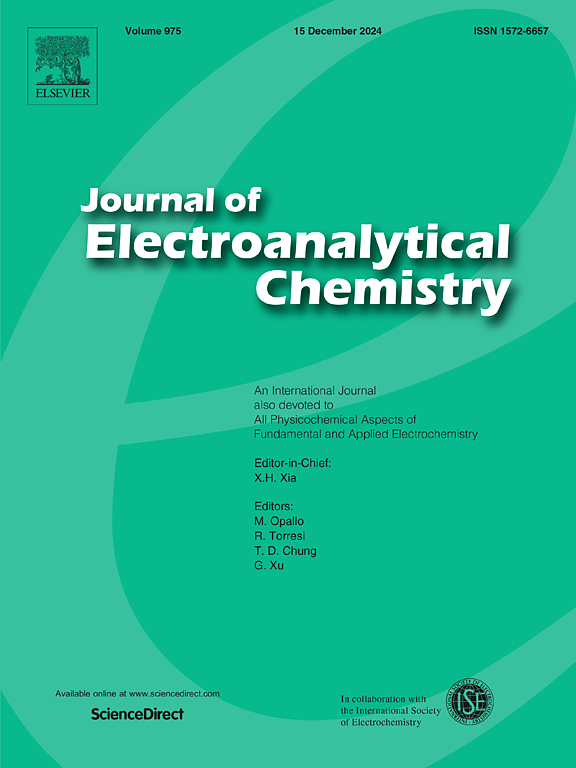β-Cyclodextrin-assisted electrochemical exfoliation of graphite for few-layer graphene synthesis
IF 4.1
3区 化学
Q1 CHEMISTRY, ANALYTICAL
引用次数: 0
Abstract
This study demonstrates that the electrochemical intercalation of graphite in the presence of self-aggregates of β-cyclodextrin (SA-βCD) dissolved in 1 mol L−1 HClO4 yields high-quality few-layer graphene (FLG). SA-βCD acts as a surfactant, facilitating exfoliation under environmentally safer conditions compared to previously reported methods. Additionally, the intercalation potential is significantly reduced compared to other media, thereby preventing the oxidation of the FLG. In the electrochemical experiments, graphite was incorporated into a carbon paste electrode and subjected to cyclic voltammetry, leading to the formation of a colloidal suspension of FLG and SA-βCD. Fourier-transform infrared spectroscopy, X-ray diffraction, ultraviolet-visible spectroscopy, and Raman spectroscopy analyses confirmed that the electrochemical exfoliation assisted by SA-βCD produced FLG without oxygen functional groups or residual SA-βCD. The electrochemical proprieties were consistent with those of graphene derivatives. Scanning electron microscopy and transmission electron microscopy analyses revealed that the FLG had large lateral dimensions ranging from 2 to 10 μm. The graphene sheets were flat and free of wrinkles, with some edges folded back on themselves or scrolled.
β-环糊精辅助石墨电化学剥落制备少层石墨烯
本研究表明,在溶解于1 mol L−1 HClO4中的β-环糊精(SA-βCD)自聚集物存在下,石墨的电化学插层可以得到高质量的少层石墨烯(FLG)。与之前报道的方法相比,SA-βCD作为表面活性剂,在更环保的条件下促进去角质。此外,与其他介质相比,插层电位显著降低,从而防止了FLG的氧化。在电化学实验中,将石墨掺入碳糊电极中,进行循环伏安法,形成FLG和SA-βCD的胶体悬浮液。傅里叶变换红外光谱、x射线衍射、紫外可见光谱和拉曼光谱分析证实,SA-βCD辅助的电化学剥离产生的FLG不含氧官能团或残留SA-βCD。电化学性能与石墨烯衍生物一致。扫描电镜和透射电镜分析表明,FLG具有较大的横向尺寸,范围为2 ~ 10 μm。石墨烯薄片平整,没有褶皱,一些边缘可以折叠起来或卷起来。
本文章由计算机程序翻译,如有差异,请以英文原文为准。
求助全文
约1分钟内获得全文
求助全文
来源期刊
CiteScore
7.80
自引率
6.70%
发文量
912
审稿时长
2.4 months
期刊介绍:
The Journal of Electroanalytical Chemistry is the foremost international journal devoted to the interdisciplinary subject of electrochemistry in all its aspects, theoretical as well as applied.
Electrochemistry is a wide ranging area that is in a state of continuous evolution. Rather than compiling a long list of topics covered by the Journal, the editors would like to draw particular attention to the key issues of novelty, topicality and quality. Papers should present new and interesting electrochemical science in a way that is accessible to the reader. The presentation and discussion should be at a level that is consistent with the international status of the Journal. Reports describing the application of well-established techniques to problems that are essentially technical will not be accepted. Similarly, papers that report observations but fail to provide adequate interpretation will be rejected by the Editors. Papers dealing with technical electrochemistry should be submitted to other specialist journals unless the authors can show that their work provides substantially new insights into electrochemical processes.

 求助内容:
求助内容: 应助结果提醒方式:
应助结果提醒方式:


